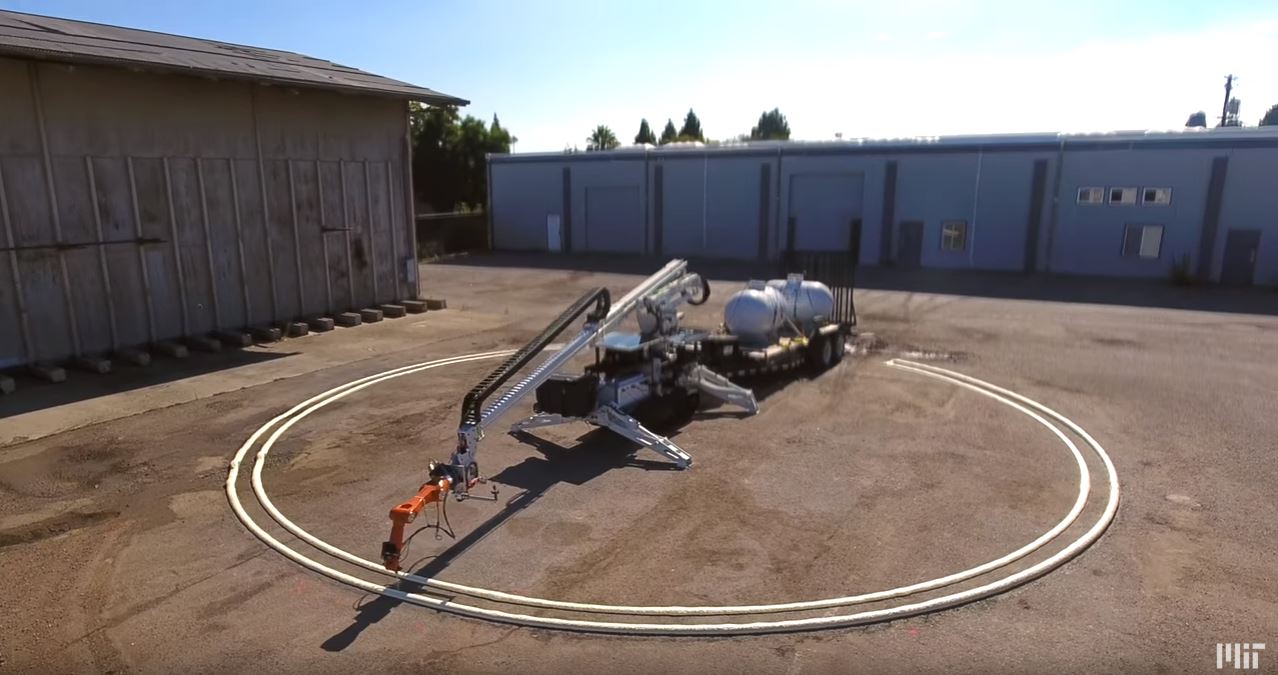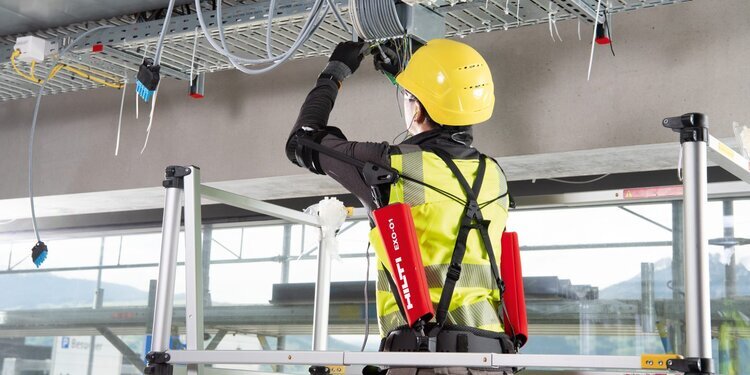via Youtube
The construction industry has historically been slow to adapt to new technologies, but with a recent push from Silicon Valley, a lot of money is being poured into research and development. Just a few short years ago, robotics on the construction site was thought of as a pipe dream, but now there are several companies around the world that are making it a reality. It still may be years away from being adopted in a large scale, but the industry should begin to take note of the technological changes that are happening around them.
Robotics isn’t the only construction item that made headlines last year, there have also been advances in construction materials, Augmented and Mixed Reality, smart sensors, and RFIDs.
Below is our list of the best advances in construction technology from 2017:
16. MIT Researchers Design a Material 10 Times the Strength of Steel
For years, scientists have known that graphene, in its two dimensional form, is one of the strongest materials on the planet. But, converting that strength into a useful three dimensional product has been a major struggle. While studying this material, MIT researchers Markus Buehler, Zhao Qin, Gang Seob Jung, and Min Jeong Kang Meng have discovered that the geometrical configuration may be more important to a material's strength the the material itself. By manipulating the structure, they believe they not only can increase the strength, but greatly reduce the weight in the process.
To illustrate their findings, the team 3D printed oddly shaped cubes of plastic and applied pressure to them. The version with thicker walls, which would seem stronger, actually failed faster than the less rigid version with thinner walls, as you can see in the video below.
Full story: MIT Researchers Design a Material 10 Times the Strength of Steel | Construction Junkie
15. New Hard Hat Attachment Senses When Workers Are Fatigued
The Life Band, as the technology is known, is a headband that can be affixed to a hard hat, or worn separately, and measures the brain activity of the wearer. The band connects wirelessly to the “Life” app, which is available for both iOS and Android, sends a warning signal if signs of fatigue are shown.
SmartCap, the manufacturer of the band, has several other versions of the product, including a baseball cap and a beanie. According to the Construction Enquirer, the technology was first developed for the mining industry. BAM Nuttall, a large contractor in the UK, is now testing the product in their rail sector for projects in Wales and will soon also test it out in Scotland.
Full story: New Hard Hat Attachment Senses When Workers Are Fatigued | Construction Junkie
14. Construction Applications Integrating with Each Other
When an entire industry is up for grabs from a technology standpoint, you are likely to see a flood of companies looking to get a piece of the pie and then, eventually, a few will rise to the top as leaders. Several programs have dominated the construction industry for years, like Autodesk’s AutoCAD and Revit, and scheduling software like Microsoft Project and Primavera, but the Project Management field has been a bit of a free-for-all.
I believe that the industry has reached a turning point and the field will start to be whittled down in the coming years. As that begins to happen, major players have started to realize that they can’t do EVERYTHING and must start to rely on other programs and applications in specific areas. They also realized that companies are already committed to other app makers and it is difficult to make them switch platforms.
Companies like Procore, Bluebeam, PlanGrid, and Autodesk's BIM 360 have recently opened marketplaces that help integrate specific software into their platform, much like how smartphone operating systems like Android’s Google Play Store and Apple’s App store function. This integration reduces the need to open several different apps at one time to complete a task or to manually transfer data from one to another. Reducing redundancies is an extremely effective way to reduce frustrations with technology.
It’s also a nice metaphor for how the construction industry operates. The main programs are acting as the GC and the secondary specialty apps function as the subcontractors. All programs will work together to help complete your project successfully.
Full stories: Procore Announces New Construction OS at Yearly Groundbreak Conference | Construction Junkie
13. Colorado DOT Tests World’s First Self-Driving Construction Vehicle
The Autonomous Impact Protection Vehicle (AIPV), also known as the Autonomous Truck Mounted Attenuator (ATMA) Truck, by Royal Truck and Equipment is a first of its kind vehicle which uses a leader-follower system to operate. Traditional TMA trucks are meant to follow work zone vehicles to protect the leader vehicle from other vehicles that may run into the back of them. The leader vehicles move slower, as they often are responsible for dropping construction barrels and completing pavement striping operations. The major problem with that is the fact that a driver is in the vehicle that’s designed to get hit with the impact.
Using a driverless vehicle to take impact makes logical sense, but how does it work? Through a system of GOS receivers, computers, a compass, and a transceiver, the driverless follower vehicle automatically adjusts speed and direction to keep up and stay a safe distance from the leader vehicle, which is operated by a human.
In conjunction with Colas (an infrastructure company in the UK), the Colorado DOT and Royal Truck and Equipment recently deployed the ATMA truck in a live work zone. Footage of the driverless truck in action was shared by CIG Public Relations and you can watch below:
Full story: [VIDEO] Colorado DOT Tests World’s First Self-Driving Construction Vehicle | Construction Junkie
12. Washington DC Contractors Add RFID Tags to Worker’s Hard Hats to Track Whereabouts
Tracking employees instantaneously is a dream scenario for employers. It gives them tons of data to analyze to determine where money can be saved and where resources can be placed to be most efficient. The struggle is convincing the employees that tracking their every move is not going to get them in trouble or fired. There’s a balance in there somewhere and that’s the challenge facing both employers and tech companies right now.
Around 20 Washington D.C. area contractors gave a new type of employee tracking device a try in 2017, according to the DCist. The software, called Eyrus, requires that unique RFID tags be placed on the hard hats of the workers on site. Sensors placed around the site can then not only monitor employee whereabouts, but can also potentially avoid labor disputes, according to the company. Nicknames and native languages of each worker can also be tracked in case of emergency.
Data gathered by Eyrus can be accessed from any web accessible device anytime. Automated reports of labor hours planned versus actual labor hours expended can be broken down by CSI division, individual company, or tradesperson, Eyrus states. Alerts can also be set up to let employers know if a project is behind schedule or labor hours are out of alignment. In case of emergency, the system will even alert the workers of the need to evacuate and takes an immediate role call of who is on site.
Full story: Washington DC Contractors Add RFID Tags to Worker’s Hard Hats to Track Whereabouts | Construction Junkie
11. America’s First Full Scale Heated Concrete Slab at an Airport
The Des Moines International Airport began testing two 15 foot by 13.5 foot test slabs of Ceylan’s electrically conductive concrete in late 2016. Throughout the winter, which happened to be fairly mild, the heating elements in the test slabs were manually managed through the use of a smartphone app.
Unlike another heated concrete that Construction Junkie wrote about that contained 20% metal and carbon particles, Ceylan’s design only uses 1% carbon fiber. Each test slab is a total of 7.5 inches thick placed in two layers, with just the top 3.5 inches are electrically conductive.
Each square meter (10.7 square feet) uses about 333 watts over 7 hours, totalling to around 19 cents in additional electric costs. The team of researchers is using plenty of tools to help them determine just how well the slabs are performing, including temperature probes, strain gauges, humidity sensors, surveillance cameras, and thermal imaging cameras.
The project has over $4.4 million in funding, split between the Center of Excellence Partnership to Enhance General Aviation Safety, Accessibility, and Sustainability (PEGASAS) and Iowa State University.
Full story: America’s First Full Scale Heated Concrete Slabs Being Tested at Iowa Airport | Construction Junkie
10. World’s First 3d Printed Excavator
The team at Oak Fridge National Laboratory unveiled the world’s first 3D printed excavator at the 2017 CONEXPO-CON/AGG in Las Vegas. The machine has 3 main 3D printed components: the stick, the cab, and the heat exchanger. The stick which measures 7 feet in length and weighs 400 pounds, is made of steel and took 5 days to print. The cab was made of carbon fiber reinforced ABS plastic and only took 5 hours to print. The heat exchanger was made of 13 pounds of aluminum, but the group has not released how long that component took to print.
Project AME, as the excavator is known, was not just unveiled at the expo to look pretty, either, it was put to work to show it could function just like a normal excavator. Equipment World was at the festivities and put together the quick video below showing the machine in action:
Full story: World’s First 3d Printed Excavator Headlines 2017 CONEXPO-CON/AGG | Construction Junkie
9. Microsoft Targeting Construction Trades with New Mixed Reality Hard Hat Accessory
Several years ago, Microsoft released their introduction into the mixed reality headset market with the Microsoft HoloLens. The headset, which looks like a pair of bulky, futuristic sunglasses, was touted as a game changer to many different industries. After teaming up with Trimble to directly tackle the construction industry and developing a couple construction technologies for the headset, construction companies have still been extremely hesitant to try out the technology.
Microsoft isn’t giving up on our industry though, as they’ve recently announced that a HoloLens hard hat accessory is in the works and will be released early 2018.
In addition to the accessory, the HoloLens has also passed some important safety and durability tests. These tests have recently confirmed that the headset meets the requirements of ANSI Z87.1, which allows them to be used as safety glasses, and it has also been rated IP50 for dust protection. The 5 indicates that dust is not completely prevented from entering the equipment, but the dust that can enter is not enough to interfere with its operation. The 0 in the second digit indicates that it does not provide any moisture protection, which could be a problem on construction sites.
In a blog post about the release announcement, Microsoft Hololens’ General Manager Lorraine Bardeen explained how she expects the updates to positively affect firstline and information workers. Some of the benefits include:
- Remote assist to allow real-time collaboration with a remote expert
- First-person perspective training manuals and how-to guides
- Augmented reality design features
- Mixed Reality Meetings
- Mixed Reality Data & Analytics
Full story: Microsoft Targeting Construction Trades with New Mixed Reality Hard Hat Accessory | Construction Junkie
8. Researchers Discover Additive to Help Concrete Withstand 9.0 Earthquakes
To help keep buildings and their occupants safe in major earthquakes, researchers at the University of British Columbia have discovered a spray-on concrete reinforcement that greatly improves concrete’s resistance to earthquakes up to a magnitude of 9.1.
Concrete walls are sprayed with the reinforcement, which is made up of “polymer-based fibers, flyash, and other industrial additives,” in a 0.4 inch (10mm) thick layer. The retrofit reinforcement allows the concrete to bend with the movement of the earthquake, making it much more ductile.
The product is being called Eco-Friendly Ductile Cementitious Composite, or EDCC, due to its heavy reliance on flyash, with is an industrial byproduct of coal.
“By replacing nearly 70 per cent of cement with flyash, an industrial byproduct, we can reduce the amount of cement used,” said UBC civil engineering professor Nemy Banthia in a press release. “This is quite an urgent requirement as one tonne of cement production releases almost a tonne of carbon dioxide into the atmosphere, and the cement industry produces close to seven per cent of global greenhouse gas emissions.”
This is an extremely interesting product to me, because, traditionally, reinforcement has always been added prior to the concrete placement or within the concrete mixture. Since this material is meant as a retrofit for existing walls, it can help save many lives in the event of an earthquake, because it won’t require extremely expensive and time consuming demolition and rebuilding of exterior walls on at-risk structures. Imagine the impacts retrofit reinforcement could have on failing infrastructure around the world.
Full story: Researchers Discover Additive to Help Concrete Withstand 9.0 Earthquakes | Construction Junkie
7. Tesla Solar Roof Shingles
There’s no better way to encourage people and companies to “go green” than to make it cool. Elon Musk is a master at making new technology cool, as we’ve seen with Telsa’s battery powered vehicles. Musk and Tesla made major headlines again last year when they announced they would begin taking orders and installing their new solar power roof shingles and then followed through on their promises. The technology also made it on our list of The 8 Most Interesting Green Building Products That Debuted in 2017.
Telsa Solar Roof turns previously a previously ugly product in solar roof panels into a basically invisible form of energy production. The solar cells are located inside of shingles themselves and, from ground level, look just like normal shingles. The shingles are currently available to order in a textured and smooth finish, but will also be available in a Tuscan style and slate look tile in the future.
Full story: First Tesla Solar Roofs Have Been Installed | Construction Junkie
6. 3D Concrete Printers That Can Print Structures in Less Than a Day
At least two robotic concrete printing machines were unveiled to the world last year, one from the Russian company Apis Cor and another from MIT.
MIT’s robotic arm concept, which you see in the video at the bottom of this article, has a lot of the same characteristics as the Russian Apis Cor robotic arm 3D printer that completed the structure of a concrete house in less than 24 hours last year. Both robots are mobile, allowing them to visit any job site, and they’re also adaptable to the specific site conditions.
The thing that sets the MIT robot apart from the Apis Cor version is that MIT’s is being designed to be completely self-sufficient, as it even has an excavator bucket attached to it in order to obtain local materials. It also can be powered by the on-board solar panels, so no need to plug it in in certain circumstances.
Although the technology is still in its infancy, all signs point to it being used first in disaster relief situations, allowing shelters to be built in remote locations in under a day.
Full story: [VIDEO] Watch a Concrete House be Printed on Site in Less Than 24 Hours | Construction Junkie
Full story: [VIDEO] MIT Shows Off 3D Printer That Can Print a Structure in 14 Hours | Construction Junkie
5. Self-Driving Track Loader Debuts on Construction Sites
Built Robotics’ Autonomous Track Loader (ATL) is powered by a rooftop cargo carrier that is filled with electronic equipment, including Light Detection and Ranging (LIDAR). LIDAR utilizes a pulsing laser in order to measure distance and range from objects around it. These lasers are specifically designed to withstand high-vibration and high-impact environments, like the ones found in the construction industry.
Once the coordinates are loaded into the ATL’s software, it uses the LIDAR and GPS, which is accurate to the nearest centimeter, to get to work cutting and dumping the soil. Another sensor on board the robot allows it to avoid collisions, but as Wired points out, a supervisor with a large red and orange kill switch must remain on site to shut it down, if needed.
The ATL is only being used on small pilot projects in the San Francisco area at the moment, but the Built Robotics team believes we’ll start seeing robots on job sites well before self-driving cars hit US roads.
This robot is not a speed demon, however, as its makers only claim that it can match the pace of a human worker. Robots can obviously make up for speed with overall duration of work, however, as long as there are not restricted work hours and noise ordinances.
Full story: Self-Driving Track Loader Debuts on Construction Sites | Construction Junkie
4. World’s First 3D Printed Bridge Officially Opens
Designed by The Institute of Advanced Architecture of Catolina (IAAC), the world’s first 3D printed pedestrian bridge was unveiled in Alcobendas, Madrid about a year ago. The bridge measures over 39 feet (12m) long and 5.7 feet (1.75m) wide and was constructed out of micro-reinforced concrete. According to ArchDaily, it took around 18 months from the time of conception to fully complete and install the bridge.
The team also faced a major design challenge, as the maximum dimensions the 3D printer could print are 6.5 feet by 6.5 feet by 6.5 feet (2m by 2m by 2m), IAAC academic director Areti Markopoulou told ArchDaily en Espanol. For the green building enthusiasts, the printing process allowed the re-distribution of raw materials, so there was minimal waste.
Full story: World’s First 3D Printed Bridge Officially Opens | Construction Junkie
3. France Officially Unveils World’s First Solar Panel Road
Using the millions of miles of roadways throughout the world to also create power seems like a no brainer, the asphalt and concrete we’re using now aren’t really accomplishing anything more than handling the traffic on the road. But, there’s also a very strong reason why those products are used: they’re strong, reliable, and relatively durable. Still, many researchers believe there is a lot of unharnessed potential for roads and the world now has a very strong test subject for the future of solar roadways in Tourouvre-au-Perche, France.
Wattway, a pholtovaltaic road pavement system, has been in development stages for the past 5 years. Colas, a worldwide infrastructure company, and INES, the National Institute for Solar Energy, joined forces to create what they think is the future of roads. Unlike other solar road systems, Wattway uses existing roads as the base and the solar panels adhere directly on top. The material, which is less than an inch thick, allows for both the thermal expansion of the material beneath, as well as the ability to handle the load from vehicles driving on it, according to the company.
Last year, a small village in France, named Tourouvre-au-Perche, became the first to have the system installed on its roads and the first in the world to have a solar road of any kind. A 0.6 mile (1km) road in the village has been covered by over 30,000 square feet (2,800 square meters) of solar panels, according to The Guardian. The road, which is expected to handle around 2,000 vehicles a day cost over $5.3 million (€5m) to complete. The panels will undergo a test period of 2 years in order to determine their true durability and figure out how much energy they can actually generate. Initial tests have indicated that it will take 215 square feet of panels to power the average French household, as panels that lay horizontal have proven to be much less efficient than those that are tilted.
Full story: France Officially Unveils World’s First Solar Panel Road | Construction Junkie
2. Exoskeleton Suits Promise Lower Fatigue, Higher Productivity for Construction Workers
The back, shoulders, and knees are often the most vulnerable body parts of any construction worker. That’s why suitX, a California-based robotics company, created the Modular Agile eXoskeleton, or MAX, for short. Sold in three separate modules, the legX, backX, and shoulderX, wearers can target one specific area, or combine all three modules for a full body exoskeleton suit.
Simply put, the MAX system reduces force on the back, legs, and shoulders through load distribution, without the need for batteries, actuators, or computers. Each module is also designed to allow for normal range of motion and to be compatible with other safety equipment, like harnesses and tool belts.
Full story: Exoskeleton Suits Promise Lower Fatigue, Higher Productivity for Construction Workers | Construction Junkie
1. World’s First Sideways- Moving Elevator Unveiled in Germany
Standard vertical elevators have had it too good, for too long. After the first cable dependent elevator was unveiled in 1857, not much has changed in the elevator industry. They’re still using cable systems and still only going up and down. But not anymore. ThyssenKrupp has officially made a multi-directional elevator a reality.
The elevator company first announced its multi-directional elevator concept in 2014 and has since been working on developing the technology. They reached a huge milestone last year, as they have finished construction of an 807 foot (246m) tall test building that has the elevator concept in it. Construction of the building, which is located in Rottweil, Germany, took roughly two and a half years.
Unlike traditional elevators, MULTI (as the concept is being called), utilizes a direct drive system that does not rely on cables to direct the cabin. Like a subway system, the cabins will all run on a loop system and utilizes a multi-level brake system. According to ThyssenKrupp, the concept allows for 50% higher transport capacity and can reduce peak power demand by up to 60%.
Sideways movement will definitely open up a new world of possibilities for future high rise construction. I’m extremely interested to see how the navigation panel looks inside the cabin. You won’t just have to choose your floor anymore, so you’ll really need to know exactly where you’re going in order to tell the elevator where to go.
Full Story: [VIDEO] World’s First Sideways- Moving Elevator Unveiled in Germany | Construction Junkie











In the midst of fierce discourse over the bipartisan infrastructure bill lies a unique opportunity for the United States.